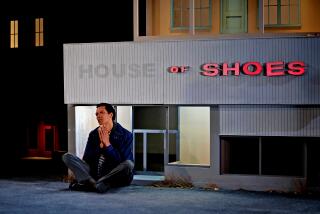TAKE A MEMORABLE WALK DOWN ‘SALVATION STREET’
If there’s one kind of play that American actors have an instinct for, it’s the small-town play. Terry Garner’s “Livin’ on Salvation Street” at the Fountain Theatre is an example. Even when the script is straining for eloquence, the players keep a firm hold on the ordinariness of the people they’re playing, and we almost believe what we’re hearing.
The scene is a living room in Cave City, Ky. The people who live there are: Granny Blue (Marie Cheatham), who once had a record on the charts and never lets you forget it; her patient daughter Mary Lou (Sharon Ernster), who keeps the family going by leading cave tours; and Mary Lou’s teen-age daughter, Wilma (Yeardley Smith), who tends to sulk.
No males around except for Wilma’s one-and-only high school chum, Clyde (John Mullican), who is, as they say in small towns, different. (The time is 1958.) Who can blame him for being that way, considering the awful way his parents died? Tell us about it, Clyde.
Like too many Southern playwrights, Garner thinks that the way to make everyday characters interesting is to have them tell stories, the more far-fetched the better. The device has its uses for backgrounding and for local color, but it’s a bad habit to get into. Plays find their life in the now, not the then. Every time “Livin’ on Salvation Street” looks back (to Granny Blue’s aborted career, to Clyde’s brutal father, to Wilma’s trip to see Elvis), it loses ground.
Besides, it’s unnecessary. This is a very simple story about a girl (Wilma) deciding to find her own path and finding that the generational opposition was chiefly token. That’s enough of a story line for a play whose chief pleasures are those of recognition: where the viewer and the playwright seem to be sharing the memory of having grown up in the same house.
That’s the money in “Livin’ on Salvation Street,” and Dorothy Lyman’s production is on it. We do recognize the house--the old, wooden ironing board, the yellowed lace tablecloth, the squat console TV. (Julie Winston and Jerry Holland did the set.) And there’s no question that these people live here. Granny Blue, for instance, gets all upset at dinner--too upset to eat. But we notice that she takes her iced tea back to the TV for comfort, when she switches on the gospel hour. This kind of detailing is worth three eccentric stories in bringing characters alive, and Lyman’s actors sustain it.
So the play establishes a mood, even as we’re doubting that young Clyde, say, really would kiss Betty Lou on the lips and propose a relationship. Again, who needs this? Clyde is thoroughly believable, as drawn by Mullican: If he smiles too much--a certain mannerly kind of boy does--there’s sadness in his need to please.
Ernster makes Betty Lou a sustainer and a believer, as true-blue as Alice Faye singing “You’ll Never Know.” Again, the performance goes to the edge of stereotype, but preserves the character’s dignity. As Granny Blue, Cheatham may be too strident, but she, too, knows her own worth.
That leaves Wilma. Smith gives her a voice you could cut keys with and the flat-eyed manner of a movie cowboy (when you call me that, smile). Odd, but then Wilma is supposed to be odd. At least she’s not a lump, a real risk with this character. Underneath the Southern gothic facade in “Livin’ on Salvation Street” there’s humanity. Lyman’s actors go for it. ‘LIVIN’ ON SALVATION STREET’
Terry Garner’s play, at the Fountain Theatre. Producers Penny Krompier Holland and Zepporah Glass Safier. Director Dorothy Lyman. Set design Julia Winston, Jerry Holland. Sound Eric Brown. Lighting David Carlton. Costumes Mary Ann Paigen. Graphics Sue Slutzky. Stage managers Leslie Stewart, Eric Brown. With Marie Cheatham, Sharon Ernster, John Mullican, Yeardley Smith. Plays at 8 p.m. Thursdays-Sundays. 5060 Fountain Ave. (213) 663-1525.
More to Read
The biggest entertainment stories
Get our big stories about Hollywood, film, television, music, arts, culture and more right in your inbox as soon as they publish.
You may occasionally receive promotional content from the Los Angeles Times.










